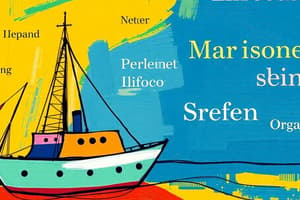Podcast
Questions and Answers
What is the most critical reason for the maritime industry's emphasis on clear and unambiguous communication?
What is the most critical reason for the maritime industry's emphasis on clear and unambiguous communication?
- To facilitate smoother catering operations and crew morale.
- To comply with local port regulations and reduce paperwork.
- To ensure all crew members can easily understand social conversations.
- To prevent misunderstandings that could lead to accidents and improve overall safety. (correct)
How does the utilization of Standard Marine Communication Phrases (SMCP) contribute to overcoming language barriers in maritime operations?
How does the utilization of Standard Marine Communication Phrases (SMCP) contribute to overcoming language barriers in maritime operations?
- By automatically translating conversations into multiple languages in real-time.
- By providing a pre-defined set of phrases for common situations, aiding effective communication regardless of native language. (correct)
- By encouraging the use of maritime slang to create a unified communication culture.
- By replacing the need for comprehensive language training, focusing on basic commands only.
Which aspect of maritime English directly addresses the challenge of varying accents and pronunciations among international seafarers?
Which aspect of maritime English directly addresses the challenge of varying accents and pronunciations among international seafarers?
- The mandatory use of nautical terminology.
- The simplified grammatical structures.
- The exclusive use of active voice in communications.
- The standardized phonetic alphabet. (correct)
In what way does the active voice preference in maritime English enhance clarity in communication?
In what way does the active voice preference in maritime English enhance clarity in communication?
How does the STCW Convention primarily influence the use and standardization of Maritime English?
How does the STCW Convention primarily influence the use and standardization of Maritime English?
What strategy would be most appropriate to mitigate the impact of noise interference on maritime communications?
What strategy would be most appropriate to mitigate the impact of noise interference on maritime communications?
How can cultural awareness training best enhance maritime communication and safety?
How can cultural awareness training best enhance maritime communication and safety?
What is the primary role of the International Maritime Organization (IMO) in the context of maritime communication?
What is the primary role of the International Maritime Organization (IMO) in the context of maritime communication?
How does continual professional development in Maritime English contribute to a seafarer's career?
How does continual professional development in Maritime English contribute to a seafarer's career?
Which technological advancement has significantly improved the efficiency and accuracy of maritime communication?
Which technological advancement has significantly improved the efficiency and accuracy of maritime communication?
What is a key challenge of implementing e-learning for Maritime English?
What is a key challenge of implementing e-learning for Maritime English?
How might the use of simulation-based training most effectively enhance Maritime English skills?
How might the use of simulation-based training most effectively enhance Maritime English skills?
What is the function of an Electronic Chart Display and Information System (ECDIS) in ensuring safer navigation?
What is the function of an Electronic Chart Display and Information System (ECDIS) in ensuring safer navigation?
What role does the Automatic Identification System (AIS) play in improving maritime communication and safety?
What role does the Automatic Identification System (AIS) play in improving maritime communication and safety?
What is the MOST significant factor contributing to miscommunication at sea?
What is the MOST significant factor contributing to miscommunication at sea?
Which action demonstrates the most effective application of Maritime English skills?
Which action demonstrates the most effective application of Maritime English skills?
How do national regulations affect the global standardization efforts in maritime communication?
How do national regulations affect the global standardization efforts in maritime communication?
Why might a preference for imperative mood be important in Maritime English?
Why might a preference for imperative mood be important in Maritime English?
Which of the following best describes the function of Very High Frequency (VHF) radio in maritime communications?
Which of the following best describes the function of Very High Frequency (VHF) radio in maritime communications?
What is the significance of the SOLAS Convention in the context of maritime communication?
What is the significance of the SOLAS Convention in the context of maritime communication?
Why is it important to avoid ambiguity in maritime communications?
Why is it important to avoid ambiguity in maritime communications?
What is the term used for the front of a ship?
What is the term used for the front of a ship?
Concerning the direction/orientation on a ship, what does "port" mean?
Concerning the direction/orientation on a ship, what does "port" mean?
What does the term "starboard" mean when referring to directions on a ship?
What does the term "starboard" mean when referring to directions on a ship?
What is a "knot" in maritime terminology?
What is a "knot" in maritime terminology?
What is a "nautical mile"?
What is a "nautical mile"?
What is the term used to describe the direction in which a vessel's bow is pointing?
What is the term used to describe the direction in which a vessel's bow is pointing?
What describes the angle at which an object appears relative to true north?
What describes the angle at which an object appears relative to true north?
What is the "draft" of a ship?
What is the "draft" of a ship?
What is the meaning of "trim" in relation to ships?
What is the meaning of "trim" in relation to ships?
In maritime terms, what does "list" refer to?
In maritime terms, what does "list" refer to?
What do the initials IMO stand for?
What do the initials IMO stand for?
Considering the convergence of maritime operations and increasing reliance on digital interfaces, what emerging challenge poses the GREATEST risk to effective communication and situation awareness on board modern vessels?
Considering the convergence of maritime operations and increasing reliance on digital interfaces, what emerging challenge poses the GREATEST risk to effective communication and situation awareness on board modern vessels?
Given the dynamic nature of maritime operations and the evolving geopolitical landscape, which strategy would MOST effectively enhance the resilience of maritime communication systems against both intentional and unintentional disruptions?
Given the dynamic nature of maritime operations and the evolving geopolitical landscape, which strategy would MOST effectively enhance the resilience of maritime communication systems against both intentional and unintentional disruptions?
In the context of modern maritime education and training, which pedagogical approach would MOST effectively address the challenge of preparing future seafarers for the complexities of intercultural communication and collaboration in diverse, multinational crews?
In the context of modern maritime education and training, which pedagogical approach would MOST effectively address the challenge of preparing future seafarers for the complexities of intercultural communication and collaboration in diverse, multinational crews?
Considering the increasing automation of onboard systems, how should the curriculum for Maritime English training adapt to MOST effectively prepare future officers to handle increasingly complex human-machine interfaces and potential system failures?
Considering the increasing automation of onboard systems, how should the curriculum for Maritime English training adapt to MOST effectively prepare future officers to handle increasingly complex human-machine interfaces and potential system failures?
Given the growing emphasis on environmental stewardship in the maritime industry, how can Maritime English training be enhanced to BEST equip seafarers to communicate effectively about complex environmental regulations, pollution prevention measures, and incident reporting procedures?
Given the growing emphasis on environmental stewardship in the maritime industry, how can Maritime English training be enhanced to BEST equip seafarers to communicate effectively about complex environmental regulations, pollution prevention measures, and incident reporting procedures?
Flashcards
Maritime English
Maritime English
A specialized subset of English used in the maritime industry for safety and efficiency.
Importance of Maritime English
Importance of Maritime English
Clear communication prevents accidents, improves operations, ensures compliance, and enables interoperability.
Key Features of Maritime English
Key Features of Maritime English
Specific words, simple grammar, phonetic alphabet, and Standard Marine Communication Phrases (SMCP).
Nautical Terminology
Nautical Terminology
Signup and view all the flashcards
Simplified Grammar in Maritime English
Simplified Grammar in Maritime English
Signup and view all the flashcards
Phonetic Alphabet in Maritime English
Phonetic Alphabet in Maritime English
Signup and view all the flashcards
Standard Marine Communication Phrases (SMCP)
Standard Marine Communication Phrases (SMCP)
Signup and view all the flashcards
Challenges in Maritime Communication
Challenges in Maritime Communication
Signup and view all the flashcards
Addressing Communication Challenges
Addressing Communication Challenges
Signup and view all the flashcards
Regulatory Framework
Regulatory Framework
Signup and view all the flashcards
Maritime English Training
Maritime English Training
Signup and view all the flashcards
Benefits of Effective Maritime English
Benefits of Effective Maritime English
Signup and view all the flashcards
Current Trends in Maritime English
Current Trends in Maritime English
Signup and view all the flashcards
Radiotelephony
Radiotelephony
Signup and view all the flashcards
Global Maritime Distress and Safety System (GMDSS)
Global Maritime Distress and Safety System (GMDSS)
Signup and view all the flashcards
Very High Frequency (VHF) Radio
Very High Frequency (VHF) Radio
Signup and view all the flashcards
Electronic Chart Display and Information System (ECDIS)
Electronic Chart Display and Information System (ECDIS)
Signup and view all the flashcards
Automatic Identification System (AIS)
Automatic Identification System (AIS)
Signup and view all the flashcards
Maritime English (IMO Definition)
Maritime English (IMO Definition)
Signup and view all the flashcards
Maritime English Vocabulary
Maritime English Vocabulary
Signup and view all the flashcards
Imperative Mood
Imperative Mood
Signup and view all the flashcards
Study Notes
- Maritime English is a specialized subset of the English language used in the maritime industry.
- It is essential for safe and efficient communication at sea, in ports, and on shore.
- Defined by the IMO as the English needed to satisfy the requirements of the STCW Convention.
Importance of Maritime English
- Safety: Clear and unambiguous communication prevents misunderstandings that could lead to accidents.
- Efficiency: Facilitates smooth operations, reducing delays and improving productivity.
- Compliance: Required by international regulations, such as the STCW Convention.
- Interoperability: Enables communication between individuals of different nationalities.
Key Features of Maritime English
- Standardized vocabulary: Uses specific terms and phrases related to maritime operations.
- Simplified grammar: Employs clear and concise sentence structures to avoid confusion.
- Phonetic alphabet: Uses a standardized phonetic alphabet to ensure accurate pronunciation.
- Standard Marine Communication Phrases (SMCP): A collection of pre-defined phrases for common situations.
Vocabulary
- Nautical terminology: Includes terms related to ship parts, navigation, cargo handling, and meteorology.
- Specialized vocabulary: Covers topics such as ship operations, safety procedures, and emergency situations.
- Abbreviations and acronyms: Uses standard abbreviations and acronyms to save time and space.
- Examples: Bow, stern, port, starboard, knot, nautical mile, heading, bearing, draft, trim, list
Grammar
- Simplified sentence structure: Uses short, direct sentences to convey information clearly.
- Active voice: Prefers active voice over passive voice for clarity and directness.
- Imperative mood: Frequently uses imperative mood for giving orders and instructions.
- Avoidance of ambiguity: Avoids using ambiguous language that could lead to misinterpretation.
Phonetic Alphabet
- Standardized system: Uses a standardized phonetic alphabet to ensure accurate pronunciation of letters and numbers.
- Ensures clarity: Prevents confusion caused by different accents and pronunciations.
- Commonly used alphabet: Alpha, Bravo, Charlie, Delta, Echo, Foxtrot, Golf, Hotel, India, Juliet, Kilo, Lima, Mike, November, Oscar, Papa, Quebec, Romeo, Sierra, Tango, Uniform, Victor, Whiskey, X-ray, Yankee, Zulu.
Standard Marine Communication Phrases (SMCP)
- IMO development: Developed by the International Maritime Organization (IMO).
- Purpose: To standardize communication at sea and reduce misunderstandings.
- Structure: Consists of phrases for specific situations, categorized by function.
- Application: Covers topics such as navigation, maneuvering, cargo handling, and emergency situations.
- Usage: Intended to be used by seafarers of all nationalities to communicate effectively.
- Examples:
- "What is your position?"
- "I am altering my course to starboard."
- "I require assistance."
Challenges in Maritime Communication
- Language barriers: Different languages and accents can make communication difficult.
- Noise: Background noise on ships and in ports can interfere with communication.
- Technical issues: Malfunctioning communication equipment can disrupt communication.
- Stress: High-stress situations can impair communication skills.
- Cultural differences: Varying cultural norms and communication styles can lead to misunderstandings.
Addressing Challenges
- Training: Providing comprehensive Maritime English training to seafarers.
- Technology: Using advanced communication technology to improve clarity and reliability.
- Standardization: Promoting the use of SMCP and other standardized communication practices.
- Cultural awareness: Fostering cultural awareness among seafarers to avoid misunderstandings.
- Continuous improvement: Regularly reviewing and updating communication practices to address emerging challenges.
Regulatory Framework
- STCW Convention: The International Convention on Standards of Training, Certification and Watchkeeping for Seafarers (STCW) sets standards for maritime education and training.
- SOLAS Convention: The International Convention for the Safety of Life at Sea (SOLAS) sets standards for maritime safety and security.
- IMO Resolutions: The IMO has issued numerous resolutions related to maritime communication and safety.
- National regulations: Many countries have their own regulations related to maritime education and communication.
Maritime English Training
- Course content: Includes vocabulary, grammar, pronunciation, and SMCP.
- Teaching methods: Uses a variety of teaching methods, such as lectures, drills, role-playing, and simulations.
- Assessment: Assesses students' language proficiency through tests, exams, and practical exercises.
- Certification: Provides certification to seafarers who meet the required standards.
- Online resources: Offers online resources for self-study and practice.
Benefits of Effective Maritime English
- Enhanced safety: Reduces the risk of accidents and injuries.
- Improved efficiency: Streamlines operations and reduces delays.
- Better communication: Enhances communication between individuals of different nationalities.
- Increased compliance: Ensures compliance with international regulations.
- Professional development: Improves seafarers' career prospects.
Current Trends in Maritime English
- E-learning: Increasing use of e-learning platforms for Maritime English training.
- Blended learning: Combining online and face-to-face instruction for a more comprehensive learning experience.
- Simulation-based training: Using simulations to provide realistic communication scenarios.
- Mobile learning: Delivering training content through mobile devices for greater accessibility.
- Focus on intercultural communication: Emphasizing the importance of cultural awareness in maritime communication.
Technological Aids
- Radiotelephony: Two-way radio communication.
- Global Maritime Distress and Safety System (GMDSS): An automated system using satellites and terrestrial communication.
- Very High Frequency (VHF) Radio: Short-range radio communication used in coastal areas and harbors.
- Electronic Chart Display and Information System (ECDIS): A digital navigation system.
- Automatic Identification System (AIS): A system that transmits information about a ship's identity, position, and course.
Studying That Suits You
Use AI to generate personalized quizzes and flashcards to suit your learning preferences.




